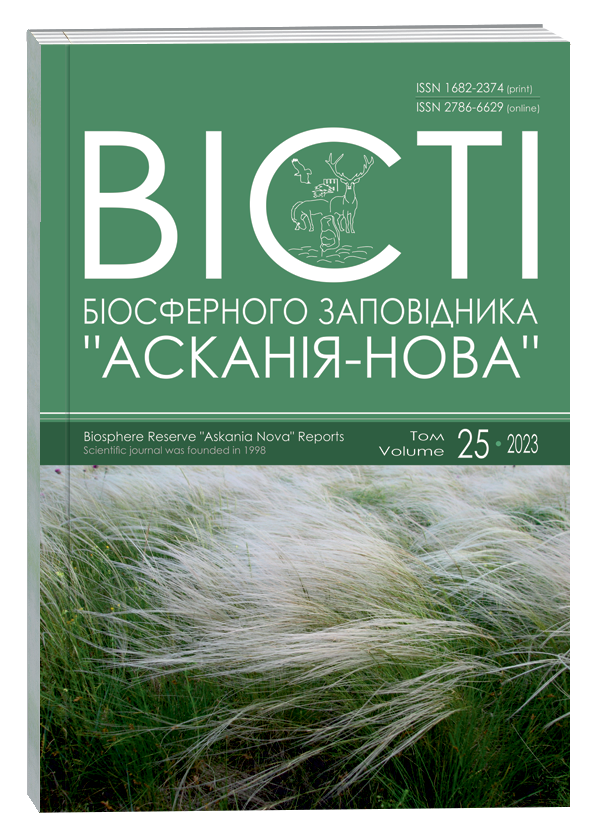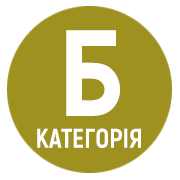EFFECTIVENESS OF POPULATION OF ARTIFICIAL NESTS IN DIFFERENT WOOD STANDS OF THE NATIONAL NATURE PARK "HUTSULSHCHYNA"
DOI:
https://doi.org/10.53904/1682-2374/2023-25/10Keywords:
Дуплогніздні птахи, результативність заселення, сови, синиця велика, мухоловка білошия, вовчок сірий, ліскулька руда, джмелі, осиAbstract
An experimental study of animal settlement of artificial nests of two structures – an owlʹs house and a titʹs house – in the forest ecosystems of the National Nature Park "Hutsulshchyna" was carried out. During 5 years of ornithological observations, 8 species of owls were encountered in the national nature park, 6 of which nest in hollows or hol-low-like hiding places: Otus scops, Aegolius funereus, Athene noctua, Glaucidium passerinum, Strix aluco, S. uralensis. Two species of owls (S. aluco and S. uralensis), Sciurus vulgaris and Martes martes settled in the owl houses of the proposed design. The experiment on attracting owls to artificial nesting boxes on the territory of the National Nature Park "Hutsulshchyna" was carried out for the first time. This is the initial stage for improving nesting conditions, first of all Strix ura-lensis – a species listed in the Red Book of Ukraine. The facts of the settlement indicate the possi-bility of increasing its number through such a biotechnical measure. The species diversity of hol-low-nesting birds of the order Passeriformes in the territory of the park, which are potentially ca-pable of inhabiting artificial nests, is 14 species. During the experiment, 5 species of birds were found in three variants of stands: Parus major, P. ater, P. caeruleus, Ficedula albicollis, Sitta eu-ropaea. Parus major shows the greatest interest in artificial nests, in particular, 78% of them were occupied in hornbeam thickets from common oak during the first egg-laying period, in fir-beech stands – 37.5%, and in pine-beech stands – 18%. The total population of artificial nests by birds during the first egg-laying period was: 94% in the hornbeam thicket from common oak, 48% in the fir-beech forest, and 26% in the pine-beech forest. Population decreases in a number of stands growing at altitudes from 350 to 650 m above sea level. The second nesting for double-nested Passeriformes in the conditions of the Pokut Carpathians is less characteristic. The population of artificial nests in different stands was 2–14.6%. Among mammals, Gliridae (Muscardinus avella-narius and Glis glis) show the greatest interest in artificial nests for Passeriformes. The population of artificial nests of Muscardinus avellanarius was traced at the end or after the completion of the first oviposition of birds. Mass settlement and hatching of Gliridae offspring took place from the second half of July to the end of August. Gliridae population was 100% in the hornbeam forest, 71% in the fir-beech forest, and 26% in the pine-beech forest. In September–October, all selective-ly tested titʹs houses in the hornbeam forest were inhabited by Glis glis and Muscardinus avella-narius in a ratio of 3:1. Artificial nests are also inhabited by wasps and bumblebees.
References
Благосклонов К. Н. Охрана и привлечение птиц. Москва : Просвещение, 1972. 238 с.
Буценко А. О., Шарлемань М. В. Приваблювання птахів. Київ : Державне видавництво літератури з будівництва і архітектури УРСР, 1960. 40 с.
Відновлення корінних природних комплексів Косівщини / Шпарик Ю. С., Стефурак Ю. П., Лосюк В. П., Гостюк З. В., Дебринюк Ю. М., Держипільський Л. М., Крамарець В. О., Пасайлюк М. В., Петричук Ю. В., Погрібний О. О., Пророчук В. В., Різун В. Б., Фокшей С. І. Косів : Писаний Камінь, 2015. 272 с. Гавриленко В. С. Рекомендации по совершенствованию методов привлечения насекомоядных птиц-дуплогнездников в лесах Молдавии. Страшены, 1987а. 10 с. Гавриленко В. С. Функциональная роль насекомоядных птиц в дубовых биогеоценозах заповедника "Кодры" при взаимодействии с консорцией дуба : Автореф. дис. … канд. биол. наук. Москва : МГУ, 1987б. 15 с. Гавриленко В. С., Гусан Г. З. Особенности расселения птиц в искусственных гнездовьях в заповеднике "Кодры". Известия АН МССР, серия биол. и хим. наук. Кишинев, 1986. Вып. 1. С. 46–50.
Горбань І. М, Скільський І. В., Мелещук Л. І. Сучасний стан орнітофауни національного природного парку "Гуцульщина". Заповідна справа в Україні. 2008. Т. 14. Вип. 2. С. 81–103.
Грищенко В. М. Практичні питання охорони птахів. Чернівці, 1995. 172 с.
Збереження видів рослин і тварин, природних середовищ, що занесені в чинні для України міжнародні переліки / Стефурак Ю. П., Держипільський Л. М., Погрібний О. О., Томіч М. В., Фокшей С. І., Пасайлюк М. В., Стефурак І. М., Петричук Ю. В., Бісько Н. А., Сухомлин М. М., Ломберг М. Л., Михайлова О. Б. Національний природний парк "Гуцульщина". Літопис природи. Т. XV. Косів, 2018. С. 168–212. Королькова Г. Е. Влияние птиц на численность вредных насекомых. Москва : АН СССР, 1963. 127 с.
Погрібний О. О., Кузьменко Ю. В. Науково-дослідні роботи по відтворенню сови довгохвостої Strix uralensis Pall. на території НПП "Гуцульщина". Національний природний парк "Гуцульщина". Літопис природи. Т. XVIII. Косів, 2021. С. 189–191.
Смогоржевський Л. О., Федоренко А. П. Охорона та приваблювання птахів. Київ : Радянська школа, 1986. 72 с.
Систематичний список тварин (анімалія) НПП "Гуцульщина" / Стефурак І. Л., Різун В. Б., Бокотей А. А., Геряк Ю. М., Скільський І. В., Горбань І. М., Череватов В. Ф., Яницький Т. М., Соколов Н. Ю., Мартинов В. В., Єндричковський В. Національний природний парк "Гуцульщина". Додаток 8. Львів : НВФ "Карти і Атласи", 2013. С. 365–388.






